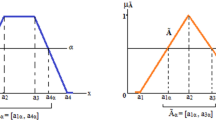Abstract
Since the failure mode and effects analysis (FMEA) technique has the advantage of simple and fast calculation, the FMEA method is widely and commonly used in solving risk assessment issues. The traditional FMEA method uses the product of risk assessment factors (occurrence, severity, and detection) to calculate risk priority number (RPN) for risk ranking. Although the RPN approach is widely adopted by the military and industry, it cannot process uncertain and incomplete information, it does not consider the relative importance of three risk assessment factors and in some situations, it loses some valuable information provided by experts. This results in the same RPN value which cannot provide the accurate risk level. In order to effectively solve these problems, this paper combined the data envelopment analysis (DEA) method and 2-tuple fuzzy linguistic representation model (2-tuple FLRM) and proposed a new model, called the 2-tuple DEA method, for ranking the risk of product (system) failures. In the numerical verification section, this paper applied the risk assessment of crawler crane to verify the rationality and correctness of the 2-tuple DEA approach. The calculation results confirm that the proposed 2-tuple DEA approach provides a more accurate failure risk ranking and retains all valuable information.



Similar content being viewed by others
References
Agrell, P. J., Mattsson, P., & Mansson, J. (2020). Impacts on efficiency of merging the Swedish district courts. Annals of Operations Research, 288(2), 653–679.
Aparicio, J., Pastor, J. T., Sainz-Pardo, J. L., & Vidal, F. (2020). Estimating and decomposing overall inefficiency by determining the least distance to the strongly efficient frontier in data envelopment analysis. Operational Research, 20(2), 747–770.
Baykasoglu, A., & Golcuk, I. (2020). Comprehensive fuzzy FMEA model: A case study of ERP implementation risks. Operational Research, 20(2), 795–826.
Behnia, F., Ahmadabadi, H. Z., Schuelke-Leech, B. A., & Mirhassani, M. (2023). Developing a fuzzy optimized model for selecting a maintenance strategy in the paper industry: An integrated FGP-ANP-FMEA approach. Expert Systems with Applications, 232, 120899.
Chang, K. H. (2016). Generalized multi-attribute failure mode analysis. Neurocomputing, 175(A), 90–100.
Chang, K. H. (2023). The D numbers risk ranking based method by considering subjective weights and objective weights with incomplete linguistic information. Journal of Intelligent & Fuzzy Systems, 44(6), 9267–9280.
Chang, D. S., & Sun, K. L. P. (2009). Applying DEA to enhance assessment capability of FMEA. International Journal of Quality & Reliability Management, 26(6), 629–643.
Chang, K. H., & Wen, T. C. (2010). A novel efficient approach for DFMEA combining 2-tuple and the OWA operator. Expert Systems with Applications, 37(3), 2362–2370.
Chang, K. H., Chang, Y. C., & Lai, P. T. (2014). Applying the concept of exponential approach to enhance the assessment capability of FMEA. Journal of Intelligent Manufacturing, 25(6), 1413–1427.
Chang, K. H., Chang, Y. C., Chain, K., & Chung, H. Y. (2016). Integrating soft set theory and fuzzy linguistic model to evaluate the performance of training simulation systems. PLos One, 11(9), e0162092.
Chang, K. H., Wen, T. C., & Chung, H. Y. (2018). Soft failure mode and effects analysis using the OWG operator and hesitant fuzzy linguistic term sets. Journal of Intelligent & Fuzzy Systems, 34(4), 2625–2639.
Charnes, A., Cooper, W. W., & Rhodes, E. (1978). Measuring efficiency of decision-making units. European Journal of Operational Research, 2(6), 429–444.
Chi, C. F., Sigmund, D., & Astardi, M. O. (2020). Classification scheme for root cause and failure modes and effects analysis (FMEA) of passenger vehicle recalls. Reliability Engineering and System Safety, 200, 106929.
Chiozza, M. L., & Ponzetti, C. (2009). FMEA: A model for reducing medical errors. Clinica Chimica Acta, 404(1), 75–78.
Chung, H. Y., & Chang, K. H. (2022). A novel general data envelopment analysis based approach for MCDM issues of hydrogen energy under a fuzzy environment. Systems, 10(5), 176.
Chung, H. Y., Chang, K. H., & Li, Z. S. (2022). A novel supplier selection approach based on extended data envelopment analysis under a hesitant fuzzy linguistic environment. International Journal of Industrial Engineering - Theory Applications and Practice, 29(5), 718–729.
Duarte, L. T., Mussio, A. P., & Torezzan, C. (2020). Dealing with missing information in data envelopment analysis by means of low-rank matrix completion. Annals of Operations Research, 286(1–2), 719–732.
Estrella, F. J., Espinilla, M., Herrera, F., & Martinez, L. (2014). FLINTSTONES: A fuzzy linguistic decision tools enhancement suite based on the 2-tuple linguistic model and extensions. Information Sciences, 280, 152–170.
Gatimbu, K. K., Ogada, M. J., & Budambula, N. L. M. (2020). Environmental efficiency of small-scale tea processors in Kenya: An inverse data envelopment analysis (DEA) approach. Environment Development and Sustainability, 22(4), 3333–3345.
Herrera, F., & Martinez, L. (2000). A 2-tuple fuzzy linguistic representation model for computing with words. IEEE Transactions on Fuzzy Systems, 8(6), 746–752.
Hussain, W., & Merigo, J. M. (2023). Onsite/offsite social commerce adoption for SMEs using fuzzy linguistic decision making in complex framework. Journal of Ambient Intelligence and Humanized Computing, 14, 12875–12894.
Hussain, W., Hussain, F. K., Hussain, O., Bagia, R., & Chang, E. (2018). Risk-based framework for SLA violation abatement from the cloud service provider’s perspective. Computer Journal, 61(9), 1306–1322.
Hussain, W., Merigo, J. M., Raza, M. R., & Gao, H. H. (2022a). A new QoS prediction model using hybrid IOWA-ANFIS with fuzzy C-means, subtractive clustering and grid partitioning. Information Sciences, 584, 280–300.
Hussain, W., Raza, M. R., Jan, M. A., Merigo, J. M., & Gao, H. H. (2022b). Cloud risk management with OWA-LSTM and fuzzy linguistic decision making. IEEE Transactions on Fuzzy Systems, 30(11), 4657–4666.
Ji, A. B., Chen, H., Qiao, Y. H., & Pang, J. H. (2019). Data envelopment analysis with interactive fuzzy variables. Journal of the Operational Research Society, 70(9), 1502–1510.
Lai, H. H., Chang, K. H., & Lin, C. L. (2019). A novel method for evaluating dredging productivity using a data envelopment analysis-based technique. Mathematical Problems in Engineering, 5130835.
Li, Z. S., & Chang, K. H. (2023). A novel pythagorean fuzzy set–based risk ranking method for handling human cognitive information in risk assessment problems. Systems, 11(6), 293.
Ma, Q. X., Zhu, X. M., Bai, K. Y., Zhang, R. T., & Liu, D. W. (2023). A novel failure mode and effect analysis method with spherical fuzzy entropy and spherical fuzzy weight correlation coefficient. Engineering Applications of Artificial Intelligence, 122, 106163.
Mete, S. (2019). Assessing occupational risks in pipeline construction using FMEA-based AHP-MOORA integrated approach under Pythagorean fuzzy environment. Human and Ecological Risk Assessment, 25(7), 1645–1660.
Minguito, G., & Banluta, J. (2023). Risk management in humanitarian supply chain based on FMEA and grey relational analysis. Socio-Economic Planning Sciences, 87, 101551.
Putra, N. U., & Wang, F. K. (2020). Integrating quality function deployment and failure mode and effect analysis in subcontractor selection. Total Quality Management & Business Excellence, 31(7–8), 697–716.
Qin, J. D., Xi, Y., & Pedrycz, W. (2020). Failure mode and effects analysis (FMEA) for risk assessment based on interval type-2 fuzzy evidential reasoning method. Applied Soft Computing, 89, 106134.
Rashid, T., Faizi, S., & Zafar, S. (2019). Outranking method for intuitionistic 2-tuple fuzzy linguistic information model in group decision making. Soft Computing, 23(15), 6145–6155.
Razipour-GhalehJough, S., Lotfi, F. H., Jahanshahloo, G., Rostamy-malkhalifeh, M., & Sharafi, H. (2020). Finding closest target for bank branches in the presence of weight restrictions using data envelopment analysis. Annals of Operations Research, 288(2), 755–787.
Sarkar, D., & Singh, M. (2022). Risk analysis by integrated fuzzy expected value method and fuzzy failure mode and effect analysis for an elevated metro rail project of Ahmedabad, India. International Journal of Construction Management, 22(10), 1818–1829.
Sarraf, F., & Nejad, S. H. (2020). Improving performance evaluation based on balanced scorecard with grey relational analysis and data envelopment analysis approaches: Case study in water and wastewater companies. Evaluation and Program Planning, 79, 101762.
Sohaib, O., Naderpour, M., Hussain, W., & Martinez, L. (2019). Cloud computing model selection for e-commerce enterprises using a new 2-tuple fuzzy linguistic decision-making method. Computers & Industrial Engineering, 132, 47–58.
Strohmandl, J., Tomek, M., Vargová, S., & Čujan, Z. (2019). The use of the FMEA method for the evaluation of failures in crawler cranes. In MATEC Web of Conferences, EDP Sciences, p. 263, Article Number: 01004.
Telles, E. S., Lacerda, D. P., Morandi, M. I. W. M., & Piran, F. A. S. (2020). Drum-buffer-rope in an engineering-to-order system: An analysis of an aerospace manufacturer using data envelopment analysis (DEA). International Journal of Production Economics, 222, 107500.
Toloo, M., & Mirbolouki, M. (2019). A new project selection method using data envelopment analysis. Computers & Industrial Engineering, 138, 106119.
Tziogkidis, P., Philippas, D., Leontitsis, A., & Sickles, R. C. (2020). A data envelopment analysis and local partial least squares approach for identifying the optimal innovation policy direction. European Journal of Operational Research, 285(3), 1011–1024.
Wen, T. C., Chang, K. H., & Lai, H. H. (2018). Improving personnel selection by combining the minimal variance OWA operator and IPA. Journal of Intelligent & Fuzzy Systems, 35(6), 6229–6239.
Wen, T. C., Chang, K. H., & Lai, H. H. (2020). Integrating the 2-tuple linguistic representation and soft set to solve supplier selection problems with incomplete information. Engineering Applications of Artificial Intelligence, 87, ArticleNumberUNSP103248.
Xu, Y. J., Ma, F., Tao, F. F., & Wang, H. M. (2014). Some methods to deal with unacceptable incomplete 2-tuple fuzzy linguistic preference relations in group decision making. Knowledge-Based Systems, 56, 179–190.
Yusuf, D., Santoso, I., & Ikasari, D. M. (2018). Sugar manufacturing process: Risk analysis and mitigation using fuzzy fmea and fuzzy ahp method. Bioscience Research, 15(3), 1575–1582.
Zare, H., Tavana, M., Mardani, A., Masoudian, S., & Saraji, M. K. (2019). A hybrid data envelopment analysis and game theory model for performance measurement in healthcare. Health Care Management Science, 22(3), 475–488.
Zhang, G. S., Zhou, S. Y., Xia, X. Y., Yuksel, S., Bas, H., & Dincer, H. (2020). Strategic mapping of youth unemployment with interval-valued intuitionistic hesitant fuzzy DEMATEL based on 2-tuple linguistic values. Ieee Access : Practical Innovations, Open Solutions, 8, 25706–25721.
Acknowledgements
The authors would like to thank the National Science and Technology Council, Taiwan, for financially supporting this research under Contract No. NSTC 111-2221-E-145-003 and NSTC 112-2221-E-145-003.
Author information
Authors and Affiliations
Corresponding author
Additional information
Publisher’s Note
Springer Nature remains neutral with regard to jurisdictional claims in published maps and institutional affiliations.
Rights and permissions
Springer Nature or its licensor (e.g. a society or other partner) holds exclusive rights to this article under a publishing agreement with the author(s) or other rightsholder(s); author self-archiving of the accepted manuscript version of this article is solely governed by the terms of such publishing agreement and applicable law.
About this article
Cite this article
Chang, KH., Chen, YJ. & Liao, CC. A novel improved FMEA method using data envelopment analysis method and 2-tuple fuzzy linguistic model. Ann Oper Res (2024). https://doi.org/10.1007/s10479-024-05998-3
Received:
Accepted:
Published:
DOI: https://doi.org/10.1007/s10479-024-05998-3




